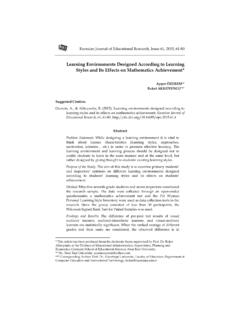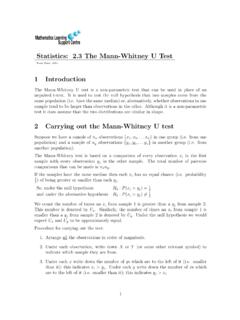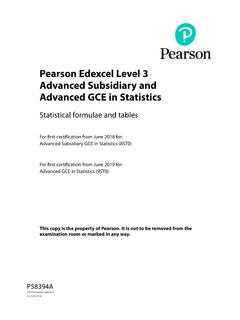Transcription of Statistics: 2.1 The sign test - www.statstutor.ac.uk
1 Statistics: The sign testRosie Shier. IntroductionMany statistical tests require that your data follow a normal distribution. Sometimesthis is not the case. In some instances it is possible to transform the data to make themfollow a normal distribution; in others this is not possible or the sample size might be sosmall that it is difficult to ascertain whether or not the data a normally distributed. Insuch cases it is necessary to use a statistical test that does not require the data to followa particular distribution. Such a test is called anon-parametricordistribution freetest.
2 The sign test is an example of one of sign test is used to test the null hypothesis that the median of a distribution is equalto some value. It can be used a) in place of a one-sample t-test b) in place of a pairedt-test or c) for ordered categorial data where a numerical scale is inappropriate but whereit is possible to rank the observations. (Note that the wilcoxon Signed rank Sum Testis also appropriate in these situations and is a more powerful test than the sign test.)2 Procedure for carrying out the sign testThe observations in a sample of sizenarex1,x2.
3 ,xn(these observations could bepaired differences); the null hypothesis is that the population median is equal to somevalue M. Suppose thatr+of the observations are greater than M andr are smaller thanM (in the case where the sign test is being used in place of a paired t-test, M wouldbe zero). Values ofxwhich are exactly equal to M are ignored; the sumr++r maytherefore be less thann we will denote it byn .Under the null hypothesis we would expect half the x s to be above the median and halfbelow. Therefore, under the null hypothesis bothr+andr follow a binomial distributionwithp=12andn=n.
4 The test procedure is as follows:1. Chooser= max(r ,r+).2. Use tables of the binomial distribution to find the probability of observing a value ofror higher assumingp=12andn=n . If the test is one-sided, this is your If the test is a two-sided test, double the probabililty obtained in (2) to obtain :The table below shows the hours of relief provided by two analgesic drugs in 12 patientssuffering from arthritis. Is there any evidence that one drug provides longer relief thanthe other?CaseDrug ADrug BCaseDrug ADrug :In this case our null hypothesis is that the median difference is zero.
5 Our actual differ-ences (Drug B - Drug A) are:+ ,+ ,+ , ,+ , ,+ , ,+ ,+ ,+ ,+ actual median difference is hours. We haver+= 9,r = 3,n= 12,r=max(r ,r+) = 9. Therefore our two-sided p-value (from binomial tables) isp= would conclude that there is no evidence for a difference between the two that the wilcoxon Signed rank Sum Test would also be appropriate in this caseand is a more powerful test because it takes account of the magnitude of the differencesas well as the Carrying out the sign test in SPSSCase 1: Paired data ChooseAnalyze SelectNonparametric tests Select2 Related Samples Specify which two variables comprise your pairs of observation by clicking on themboth then clicking on the arrow to put them underTest Pair(s) List.
6 UnderTest TypeselectSign Click onOKThe output will look like this:FrequenciesNDrug B - Drug A Negative Differencesa3 Positive Differencesb9 Tiesc0 Total12a. DRUGB<DRUGAb. DRUGB>DRUGAc. DRUGA = DRUGB2 Test StatisticsbDRUGB - DRUGAE xact Sig. (2-tailed) Binomial distribution sign TestIf you were carrying out a one-sided test, you would need to divide the p-value by 2: Single set of observationsNote that in this case SPSS includes values that are exactly equal to the median ittakesr+= the number of observations that are greater than M andr = the numberof observations that are less than or equal toM.
7 Any ties should therefore be excludedmanually as follows: chooseDatathenSelect Cases; chooseIf condition is satisfiedand click onIf; in the box type in your variable name then6=M, where M is the medianvalue specified in your null hypothesis; click onContinuethenOKand proceed asdetailed below. ChooseAnalyze SelectNonparametric tests SelectBinomial Choose the relevant variable as theTest Variable UnderDefine Dichotomyin the lower left hand corner of the pop-up screen, chooseCut Pointand specify your null value ( 0 in the case of paired data, etc.)
8 Click onOKThe output will look like this:Binomial TestCategoryNObservedTest (2-tailed)Drug B - Drug A Group 1 2> you were carrying out a one-sided test, you would need to divide the p-value by







